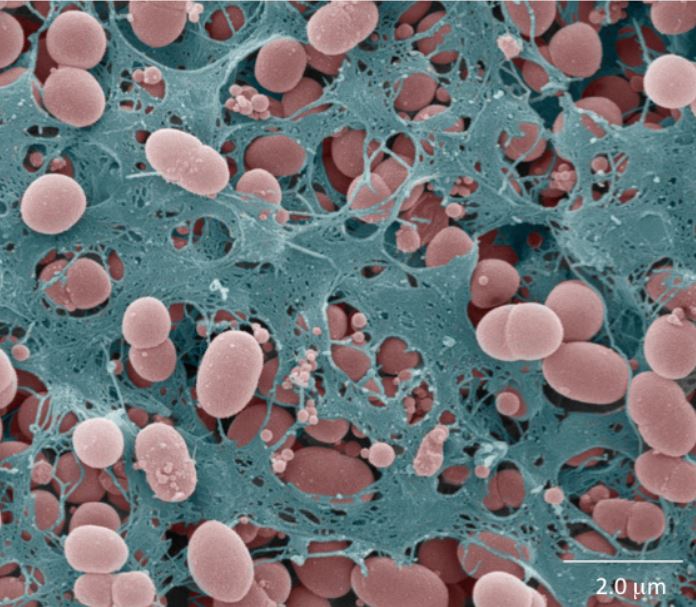Research team creates new possibilities for medicine and materials sciences

Netze von modifizierter Zellulose in der extrazellulären Matrix, die einen Biofilm von Escherichia coli‐Zellen zusammenhält (rasterelektronenmikroskopische Aufnahme in Falschfarben) Abbildung: Diego Serra und Regine Hengge
Cellulose produced by plants and bacteria is the most important material of biological origin on the planet. Acting as the main component in plant cell walls, cellulose gives plants their strength and flexibility. Wood, cotton and linen are made up almost exclusively of this material.
Now, the research team headed up by Prof. Dr. Regine Hengge, of the Humboldt-University of Berlin (HU) and her colleague, Prof. Dr. Lynette Cegelski, from Stanford University (California) has discovered that bacteria can not only produce cellulose, but can also chemically modify it using enzymes.
The discovery of this process opens up entirely new prospects: in the fight against diseases, for example. Pathogens such as salmonella modify cellulose in order to bind onto biofilms.
Through this mechanism, they can protect themselves from antibiotics and the immune system, and cause chronic infections.
Using targeted molecular design of enzymes, a diverse range of cellulose variants could be created in the future, with material properties that would have been completely inconceivable until now.
The detailed research results were published in the specialist journal, Science.
Publication
Thongsomboon, W., Serra, D.O Thongsomboon, W., Serra, D.O., Possling, A., Hadjineophytou, C., Hengge*, R., Cegelski,* L. (2018): Phosphoethanolamine cellulose: A naturally produced chemically modified cellulose. Science, 19 January 2018
*both of the final two authors cited are corresponding authors
Link
http://science.sciencemag.org/content/359/6373/334
Contact
Prof. Dr. Regine Hengge
Institute of Biology
Humboldt-Universität of Berlin
Tel.: 030 2093-49684
regine.hengge@hu-berlin.de
Media Contact
More Information:
http://www.hu-berlin.de/All latest news from the category: Life Sciences and Chemistry
Articles and reports from the Life Sciences and chemistry area deal with applied and basic research into modern biology, chemistry and human medicine.
Valuable information can be found on a range of life sciences fields including bacteriology, biochemistry, bionics, bioinformatics, biophysics, biotechnology, genetics, geobotany, human biology, marine biology, microbiology, molecular biology, cellular biology, zoology, bioinorganic chemistry, microchemistry and environmental chemistry.
Newest articles

Trotting robots reveal emergence of animal gait transitions
A four-legged robot trained with machine learning by EPFL researchers has learned to avoid falls by spontaneously switching between walking, trotting, and pronking – a milestone for roboticists as well…

Innovation promises to prevent power pole-top fires
Engineers in Australia have found a new way to make power-pole insulators resistant to fire and electrical sparking, promising to prevent dangerous pole-top fires and reduce blackouts. Pole-top fires pose…

Possible alternative to antibiotics produced by bacteria
Antibacterial substance from staphylococci discovered with new mechanism of action against natural competitors. Many bacteria produce substances to gain an advantage over competitors in their highly competitive natural environment. Researchers…





















